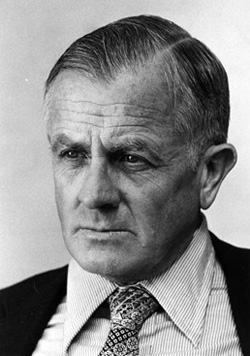The travellers
The samples of technological artefacts from the survey of Iran Afghanistan and Turkey, were collected by a group of luminaries. The team included, in alphabetical order (not all the expedition members visited all the countries or all the sites):
 |
|
Theodore A. Wertime (photograph courtesy of John Wertime) |
Sam Bingham, team's photographer;
Fred Klinger, the geologist;
Fred Matson, ceramicist from Philadelphia, Pennsylvania;
Ezat Neghahban, eminent Iranian archaeologist living in the USA;
Three archaeometallurgists:
Radomir Pleiner from Prague;
Beno Rothenberg from Tel Aviv;
Ronald Tylecote from Newcastle-upon-Tyne;
finally John Wertime, one of Theodore's sons and
Theodore Wertime.
Having received the artefacts it took over a year to identify these various members of the expedition, and contact those still alive.
Theodore Wertime: former Cultural attaché in Iran, then Research Associate of the Smithsonian Institution and editor of Forum for the voice of America, specialist in the history of pyrotechnology. He was the organiser, a diplomat and a respected scholar. His son John Wertime was part of the 1968 expedition, but unfortunately had handed over his father’s notes to his father’s colleague who died soon after, and so they are lost (Wertime F03). Wertime, having secured funding from the Smithsonian, went about inviting a carefully selected group of archaeologists. In a letter from Wertime to Braidwood (who was involved in ground breaking work in the region), he mentions the planned survey and names of seven people he is sounding out for the journey (Wertime B01). Not all mentioned did travel and other scholars were included in the expedition when it took place. For example an Iranian geologist working in USA Shekharchi, who had traveled with Wertime on the 1967 expedition was mentioned, but due to other commitments, helped establish the route for the 1968 survey and then handed the job over to Klinger (Klinger, D01). Of those who traveled two are sadly deceased. I enclose the professional positions of the travellers at the time of the survey, and a brief summary of dealings with them.
Professor Beno Rothenberg (Director of Haaritz Museum in Tel Aviv, author of numerous studies on metallurgy), had curated the collection for the past 30 years and kindly donated the artefacts to the IoA for me to catalogue, along with a copy of his field note book and photographs he had taken.
With Professor Rehren’s help I got in touch with Professor Radomir Pleiner (member of the Archaeological Institute in Prague and leading European expert on iron, also part of the 1966 Wertime expedition to Iran), whose concise and beautifully presented reports collected from various expedition members are a Godsend.
Thankfully the British Museum had inherited the notes of Professor Ronald F. Tylecote, (Professor of Metallurgy at the University of Newcastle-upon-Tyne) which Dr Craddock kindly located, amongst these I found Tylecotes’s field notebook and highly interesting correspondence.
Dr Robert Brill (Director of the Corning Museum of Glass and expert on glass, glazes and metallurgy), whose slides and notes were destroyed in a flood, was able to extract some information from a small notebook that had survived. He also kindly helped me find other members of the expedition.
Dr Fred Matson (Professor of Archaeology at Penn State University and well known authority on ceramics), I have sent correspondence to and had a conversation with on the phone; hopefully he may locate his old notes.
I was lucky to find Sam Bingham the photographer (he was a reporter injured in the then recent Vietnam war), when I contacted Mr. Bingham he had just moved house, and was not able to send any information from the survey, but did send an interesting, more sociological account of the journey.
Fred Klinger was the missing link to the geological aspects of the survey, and happily he was located as well and provided an excellent published geological report of the survey.
I was unable to contact Professor Ezat Neghahban, now living in the USA, an eminent Iranian archaeologist who was involved in part of the journey.
This multi-disciplinary team gathered and perceived varied data, of which the collection at the Institute comprises most of the metallurgical samples collected.
All the members of the expedition were not present at all the sites, not all took the same route and some members collected samples for their own use.
